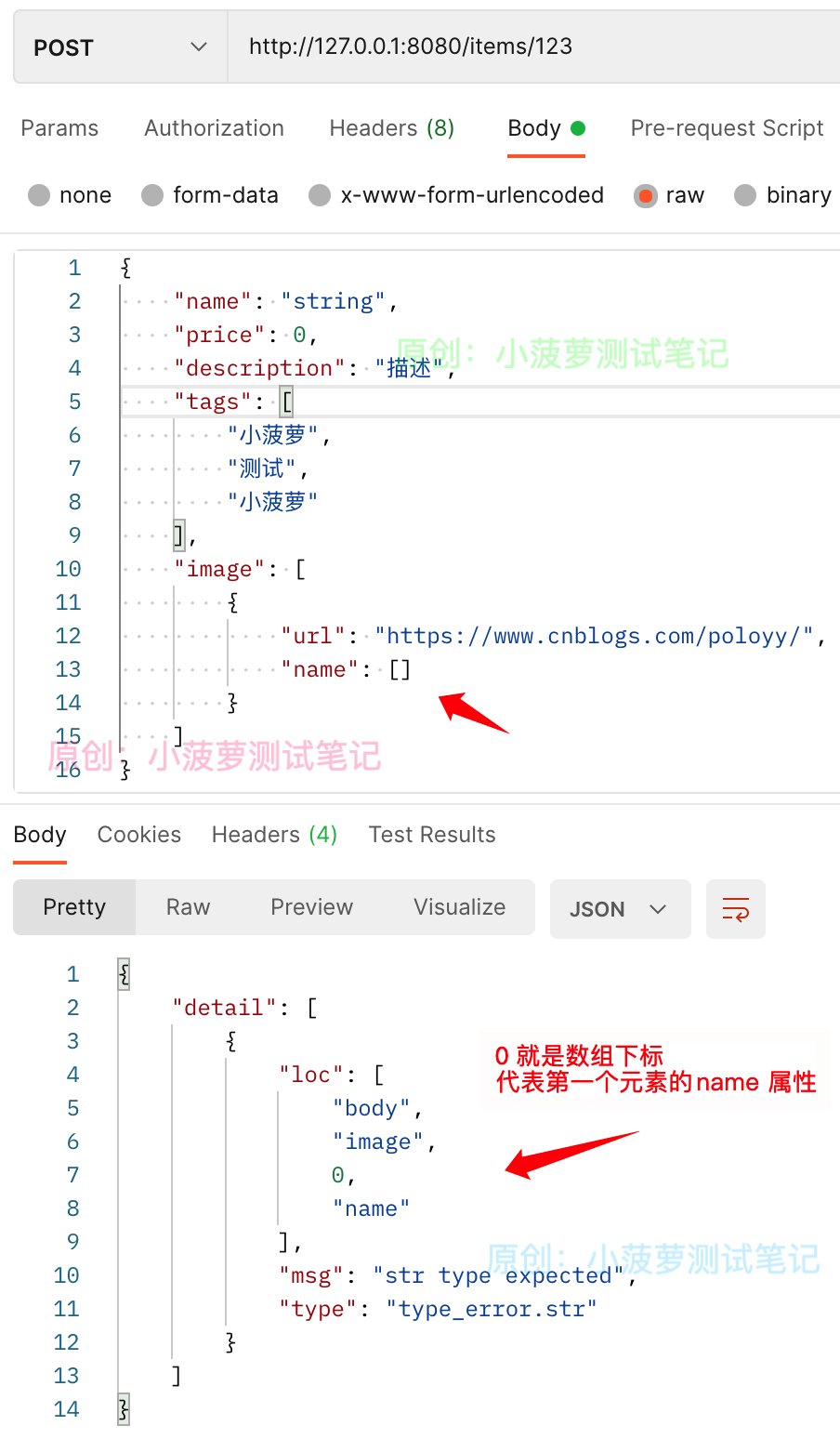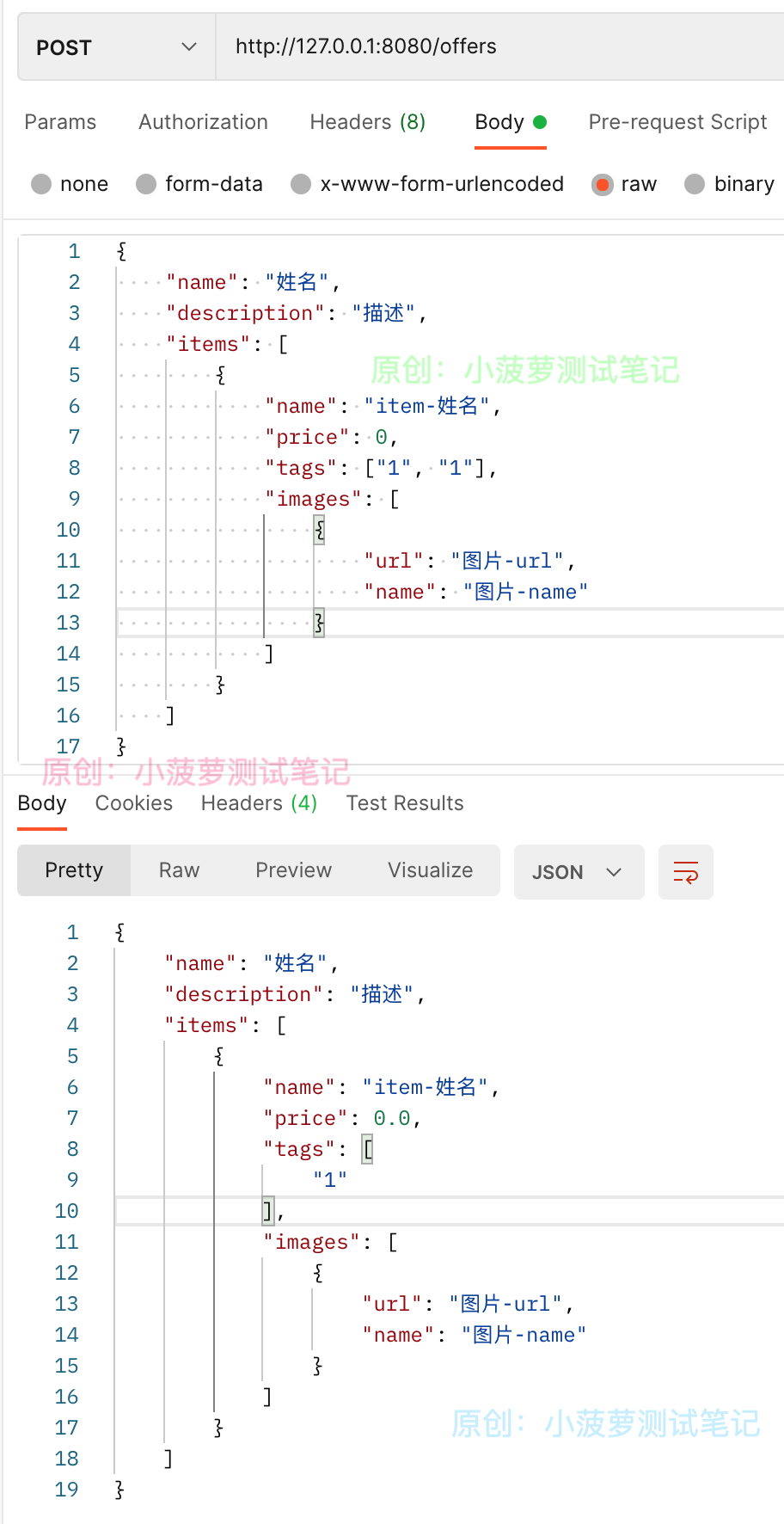FastAPI(14)- 路径操作函数参数的类型是一个嵌套 Pydantic Model 的使用场景
FastAPI(14)- 路径操作函数参数的类型是一个嵌套 Pydantic Model 的使用场景
带有类型参数的字段
Python 有一种特定的方法来声明具有内部类型或类型参数的列表
其实前面都见过,就是
List[str]
Set[str]
Tuple[str]
Dict[str, int]
- List、Set、Tuple、Dict 都是从 typing 模块中导入的
- typing 常见类型提示,详细教程:https://www.cnblogs.com/poloyy/p/15150315.html
在 Pydantic Model 中使用 typing 提供的类型
from typing import List, Optional, Set, Dict, Tuple
from pydantic import BaseModel
class Item(BaseModel):
name: str
description: Optional[str] = None
price: float
tax: Optional[float] = None
tags: List[str] = []
address: Set[str] = set()
phone: Tuple[int] = ()
ext: Dict[str, str] = {}
item = Item(name="小菠萝", price=12.2)
print(item.dict())
输出结果
{
"name": "小菠萝",
"description": None,
"price": 12.2,
"tax": None,
"tags": [],
"address": set(),
"phone": (),
"ext": {}
}
Pydantic 嵌套模型
from typing import List
from pydantic import BaseModel
# 模型 1
class Foo(BaseModel):
count: int
size: float = None
# 模型 2
class Bar(BaseModel):
apple = 'x'
banana = 'y'
# 模型 3
class Spam(BaseModel):
# 字段类型是 Pydantic Model,这就是嵌套模型
foo: Foo
bars: List[Bar]
f = Foo(count=2)
b = Bar()
s = Spam(foo=f, bars=[b])
print(s.dict())
输出结果
{
"bars": [
{
"apple": "x",
"banana": "y"
}
],
"foo": {
"count": 2,
"size": 1
}
}
FastAPI 中使用 Pydantic 嵌套模型
#!usr/bin/env python
# -*- coding:utf-8 _*-
"""
# author: 小菠萝测试笔记
# blog: https://www.cnblogs.com/poloyy/
# time: 2021/9/19 9:40 下午
# file: 12_model.py
"""
from typing import List, Optional, Set, Dict, Tuple
import uvicorn
from pydantic import BaseModel
from fastapi import FastAPI
app = FastAPI()
class Item(BaseModel):
name: str
description: Optional[str] = None
price: float
tax: Optional[float] = None
tags: List[str] = []
address: Set[str] = set()
phone: Tuple[int] = ()
ext: Dict[str, str] = {}
# 模型一
class Image(BaseModel):
url: str
name: str
# 模型二
class Item(BaseModel):
name: str
price: float
description: Optional[str] = None
tags: Set[str] = set()
# Image 模型组成的列表类型
image: Optional[List[Image]] = None
@app.post("/items/{item_id}")
async def update_item(
item_id: int,
# 声明类型为:嵌套模型的 Item
item: Item):
results = {"item_id": item_id, "item": item}
return results
if __name__ == "__main__":
uvicorn.run(app="12_model:app", host="127.0.0.1", port=8080, reload=True, debug=True)
期望得到的请求体
{
"name": "string",
"price": 0,
"description": "string",
"tags": [],
"image": [
{
"url": "string",
"name": "string"
}
]
}
重点
tags 虽然声明为 Set(),但在接口层面并没有集合这个概念,所以还是传数组 [ ] 格式哦,并不是传 { } 哦
但是!集合的特性仍然会保留:去重
FastAPI 给嵌套模型提供的功能
和前面讲的没什么区别
- IDE 智能代码提示,甚至对于嵌套模型也支持
- 数据转换
- 数据验证
- OpenAPI 文档
正确传参的请求结果
校验失败的请求结果
查看 Swagger API 文档
深层次嵌套模型
# 更深层嵌套
from typing import List, Optional, Set
from fastapi import FastAPI
from pydantic import BaseModel
app = FastAPI()
# 模型一
class Image(BaseModel):
url: str
name: str
# 模型二
class Item(BaseModel):
name: str
price: float
tags: Optional[Set[str]] = set()
images: Optional[List[Image]] = None
# 模型三
class Offer(BaseModel):
name: str
description: Optional[str] = None
items: List[Item]
@app.post("/offers/")
async def create_offer(offer: Offer):
return offer
期望得到的请求体
{
"name": "string",
"description": "string",
"items": [
{
"name": "string",
"price": 0,"tags": [],
"images": [
{
"url": "string",
"name": "string"
}
]
}
]
}
正确传参的请求结果
IDE 提供的智能提示
即使是三层嵌套模型,也可以拥有丝滑般的代码提示哦
分类:
fastapi











【推荐】国内首个AI IDE,深度理解中文开发场景,立即下载体验Trae
【推荐】编程新体验,更懂你的AI,立即体验豆包MarsCode编程助手
【推荐】抖音旗下AI助手豆包,你的智能百科全书,全免费不限次数
【推荐】轻量又高性能的 SSH 工具 IShell:AI 加持,快人一步
· Manus重磅发布:全球首款通用AI代理技术深度解析与实战指南
· 被坑几百块钱后,我竟然真的恢复了删除的微信聊天记录!
· 没有Manus邀请码?试试免邀请码的MGX或者开源的OpenManus吧
· 园子的第一款AI主题卫衣上架——"HELLO! HOW CAN I ASSIST YOU TODAY
· 【自荐】一款简洁、开源的在线白板工具 Drawnix
2021-01-05 K8s - Kubernetes重要概念介绍(Cluster、Master、Node、Pod、Controller、Service、Namespace)
2021-01-05 Dockerfile文件详解
2021-01-05 k8s简介
2021-01-05 mongodb存储过程
2021-01-05 存储过程详解